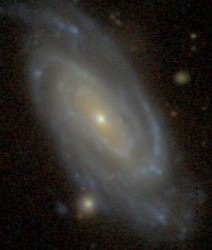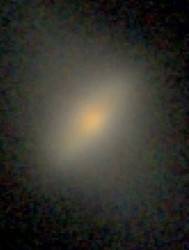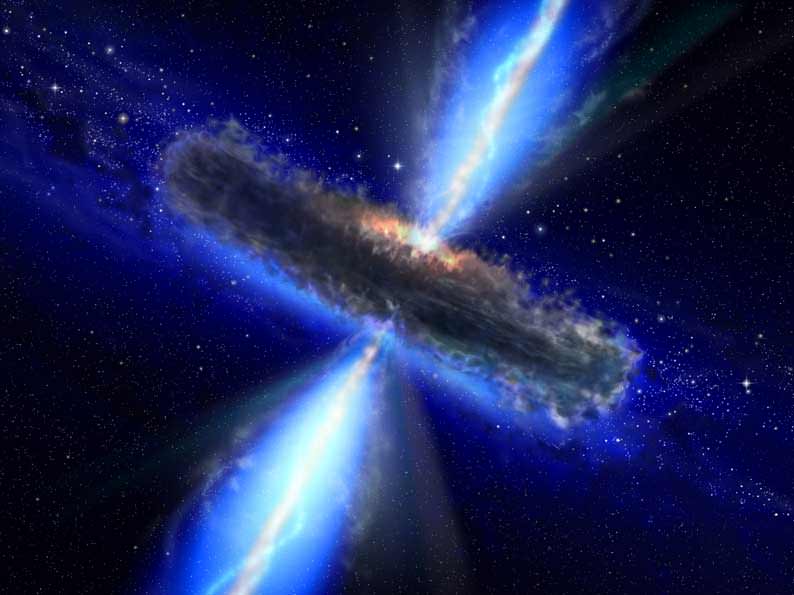[/caption]
NASA’s Swift spacecraft is designed to hunt for gamma-ray bursts. But in the time between these almost-daily cosmic explosions, Swift’s Burst Alert Telescope (BAT) scans the sky, performing an ongoing X-ray survey. Some of the first results of that survey were shared at the American Astronomical Society meeting in Long Beach, California. The BAT is revealing differences between nearby active galaxies and those located about halfway across the universe. Understanding these differences will help clarify the relationship between a galaxy and its central black hole. But unlike most telescopes, the BAT observations are not done with mirrors, optics or direct focusing. Instead, images are made by analyzing the shadows cast by 52,000 randomly placed lead tiles on 32,000 hard X-ray detectors. And BAT is becoming a workhorse: The survey is now the largest and most sensitive census of the high-energy X-ray sky.
“There’s a lot we don’t know about the workings of supermassive black holes,” says Richard Mushotzky of NASA’s Goddard Space Flight Center in Greenbelt, Md. Astronomers think the intense emission from the centers, or nuclei, of active galaxies arises near a central black hole containing more than a million times the sun’s mass. “Some of these feeding black holes are the most luminous objects in the universe. Yet we don’t know why the massive black hole in our own galaxy and similar objects are so dim.”
“The BAT sees about half of the entire sky every day,” Mushotzky said. “Now we have cumulative exposures for most of the sky that exceed 10 weeks.”

Galaxies that are actively forming stars have a distinctly bluish color (“new and blue”), while those not doing so appear quite red (“red and dead”). Nearly a decade ago, surveys with NASA’s Chandra X-Ray Observatory and ESA’s XMM-Newton showed that active galaxies some 7 billion light-years away were mostly massive “red and dead” galaxies in normal environments.
The BAT survey looks much closer to home, within about 600 million light-years. There, the colors of active galaxies fall midway between blue and red. Most are spiral and irregular galaxies of normal mass, and more than 30 percent are colliding. “This is roughly in line with theories that mergers shake up a galaxy and ‘feed the beast’ by allowing fresh gas to fall toward the black hole,” Mushotzky says.

Until the BAT survey, astronomers could never be sure they were seeing most of the active galactic nuclei. An active galaxy’s core is often obscured by thick clouds of dust and gas that block ultraviolet, optical and low-energy (“soft”) X-ray light. Dust near the central black hole may be visible in the infrared, but so are the galaxy’s star-formation regions. And seeing the black hole’s radiation through dust it has heated gives us a view that is one step removed from the central engine. “We’re often looking through a lot of junk,” Mushotzky says.
But “hard” X-rays — those with energies between 14,000 and 195,000 electron volts — can penetrate the galactic junk and allow a clear view. Dental X-rays work in this energy range.
Astronomers think that all big galaxies have a massive central black hole, but less than 10 percent of these are active today. Active galaxies are thought to be responsible for about 20 percent of all energy radiated over the life of the universe, and are thought to have had a strong influence on the way structure evolved in the cosmos.
The Swift spacecraft was launched in 2004.
Source: NASA


I do not want to be the first to comment
My immediate reservation is simply that in every other branch of astronomy we have the advantage of actual images rather than an “illustration” taken, not by the astronomical instrument, but from the imagination of the illustrator. If we are to believe the “illustration” we also need to see for ourselves the raw data image so that we can all compare our interpretation with that of the illustrator. Without that back up of real data, no one can be certain that the illustration is accurate and if there is an aspect of interpretation, then who is the official arbiter of the imagination of the illustrator? No disrespect made or intended to the illustrator of the above “illustration”.
ScepticTim:
Sorry for not using the correct the term of art. Still, the “black hole” theory postulates a black hole’s gravitational pull is strong enough to capture light and all other matter.
The abstract mathematical theory postulating the existence of “black holes” doesn’t say they are “super dense” rather it postulates a “point” with infinite or near infinite gravitational pull.
Why is infinite or near infinite required by gravitational theory? Because gravity is a recognized “weak ” force.
You simply can’t get “there” (gravity being strong enough to capture light) without shooting up the gravitational pull to infinity or near infinity.
So while you can point out my failure to use correct terms of art, I’ll point out your description of a “black hole” is a palatable description which is itself a failure to use correct terms of art.
More to the point of my comment is that the observations and theory are in contradiction.
Hikker 9965 is correct when he states that Plasma Cosmology explains this observation better than “black hole” theory.
I have no qualms about using an illustration to represent a complex, many faceted concept that has been confirmed and published in a peer-reviewed article (e.g. extrasolar planets with known properties derived from astronomical observations). Not all astronomical discoveries lend themselves to photogenic illustrations of the observed phenomena. I also wonder if other Xray telescopes( such as Chandra, XMM-Newton, Integral, ASCA, to name a few) lend themselves to similar observations along these lines & if time is available on them to conduct such a survey. Great article, Nancy, & kudos to Pavo Padovani for his excellent interpretation of an obscured AGN in a galaxy.
Beautiful illustration and as I understand galaxy dynamics faithful to the energies released, detected, and measured, however, this illustration contradicts the idea of “black holes”.
Too much energy released from the center, and an accretionary disc would not be able to eject material with such energy and, of course, “black holes” supposedly suck in all matter even light.
So, there is a contradiction between the observation (aided by the artist’s rendering) and the theory.
Observation and measurement win every time.
This illustration and the raw data supporting it are more consistent with electromagnetic dynamics as opposed to gravitational dynamics.
Re:Anaconda: your observation that “…”black holes” supposedly suck in all matter even light…” is not correct.
Black holes do not ‘suck’. A black hole is simply a “super dense” object with a gravitational well consistent with its size and mass. For example, if the sun were replaced with a black hole having the same mass, the orbits of the planets would not noticeably change – the radiation environment might, however, be uncomfortable.
All very well and good. I appreciate your time laying out the description, but the problem still remains: The observation contradicts basic “black hole” theory, namely, that “black holes” derive from a collasped stars. Stars are a product of galaxies.
Rather, than providing a detailed description based on theoretical, mathematical assumptions, a more fruitful approach might be to consider the possibility that Electric Universe theory has a better explanation:
“Black holes” don’t exist so there is no chicken and the egg dilemma and the contradiction this observation imposes on “black hole” theory is therefore moot.
That artist’s rendition of a galaxy looks quite a bit like what the Electric Universe proponents might draw. Look at those filiments.
I thought the EU’s ideas were banned by mainstream astronomy. This artist will probably never have another drawing published again. Sad.
The evidence in favor of the EU is clear. Its time to call off the search for black holes. They don’t exist.
Re: Anaconda
“Still, the “black hole” theory postulates a black hole’s gravitational pull is strong enough to capture light and all other matter.The abstract mathematical theory postulating the existence of “black holes” doesn’t say they are “super dense” rather it postulates a “point” with infinite or near infinite gravitational pull.”
A black hole can be considered to be an object, of sufficiently great mass and small volume, by an observer outside of the black hole, that this object has an event horizon. The event horizon acts as a one way membrane. Due to the strong gravitational field near the black hole, the light cones of the space time get tilted, so much so that their exterior boundary lies tangent to the horizon. The horizon thus acts as a one way membrane, i.e., no object, not even a light ray, that crosses it inwards can ever cross it back outwards. The exterior observer cannot have access to what formed the black hole. The only thing the observer probes is the black hole mass M, electromagnetic charge Q, and
angular momentum J. (Sometimes referred to as a black hole has no hair.) As a result, any physical quantity, such as energy, entropy or information, that is dumped into the black hole remains permanently trapped inside, classically. The only way that an object will cross the event horizon is if it is falling into the black hole, similar to the way an object will fall into a star or the sun if it is not in a suitable orbit.
From the point of view of an observer (or object) outside the black hole we can ignore the physics inside the black hole (which is still a subject of much theoretical research.) and treat it as an object with specific dimensions and mass. For the mass of the Sun the event horizon radius is approximately 3 km. This object will then behave as if it were simply a very dense “star” and objects near it will behave classically. This object cannot “suck”. If the sun suddenly were to collapse (extremely improbable) into a black hole, the planets and other bodies would continue merrily on in their respective orbits: they would not be “sucked” into the sun.
Pawel O. Mazur1, and Emil Mottola2 have suggested an alternate endpoint for gravitational collapse in “Gravitational Condensate Stars: An Alternative to Black Holes” (arXiv:gr-qc/0109035 v5 27 Feb 2002)
By extending the concept of Bose-Einstein condensation to gravitational systems, a cold, compact object with an interior de Sitter condensate phase and an exterior Schwarzschild geometry of arbitrary total mass M is constructed. They show that an explicit static solution of Einstein’s eqns. taking quantum considerations into account exists, with the critical surface replaced by a thin shell of ultra-relativistic fluid of soft quanta obeying ? = p. Such a solution, lacking a singularity and an horizon is significant because it provides a stable alternative to black holes as the endpoint of gravitational collapse, possibly with different observational signatures. The assumption required for this solution to exist is that gravity undergoes a vacuum rearrangement phase transition in the vicinity of r = R_S . Where R_S = 2GM is the Schwarzschild radius corresponding to an infinite blue shift of the frequency of an infalling light wave with respect to its frequency far from the object. ( Strictly speaking the Schwarzschild radius is the event horizon in a non-rotating body. A rotating black hole can produce large amounts of energy at the expense of its rotational energy. In that case a rotating black hole gradually reduces to a Schwarzschild black hole.)
There have also been other descriptions of the theoretical physics that may obtain inside of the event horizon. In any case, for an observer far from the object, it can be considered to be simply a “very dense object”.
sorry, the equation “…soft quanta obeying ? = p.” should read …soft quanta obeying rho = p.”
Aodhhan:
All your statements, this and that demonstrate how “off” current astromy is.
You imagine this and that, but in reality “black holes” have never been observed, they are a product of mathematical abstraction, and “black holes” are so etheral that they end up being a rorschach test for your imagination.
You need to get back to what science does best, observation and measurement.
Yet, that would prevent you from day-dreaming about “black holes” because there is no observation and measurement that verifies their reality.
Why were all these “unobserved” objects thought of at all?
Because the gravitational model didn’t work without them.
Think of that: These objects would not even been dreamed of if the gravitational model worked without them. But it didn’t, so these objects were “theorized” to exist because they just had to because the gravitational has to be correct.
That is a brutally naked assumption.
A theory that has to theorize “unseen” phenomenon to make it work is in trouble.
The center of galaxies is a plasmoid of electrical energy. Electrical currents are the predominate force in the Universe and gravity only has a secondary role, admittedly primary in the absence of charged bodies, but since 99% of the Cosmos is plasma, this limits gravity opportunity to be the predominate force.
The surface of the Earth is a neutral environment — solids, liquids, and neutral gases predominate, but in space plasma — charged particles, both electrons and ions predominate and flow in electric currents, Birkeland currents, that NASA has verfied flow from the Sun to the Earth.
That is why Man’s science is slow to recognize plasma dynamics in space, because Man’s first venue of scientific inquiry, the surface of the Earth is devoid of plasma.
But in space it is entirely different — space probes are confriming the presence of electric currents and those scientific observations will only mount with time.
You guys are both half right, and half wrong… along with using the correct words, just not in the correct way.
There are different parts and stages to black holes, and different things happen in all of them, and at times you are getting them mixed, and the paraphrasing of information you have found….somewhere… isn’t exactly making you look good.
There is a lot more to black holes than what you guys are attempting to state here… and there are plenty of good places to educate yourself, just make sure they are reputable.
Kill the word “Postulate” I don’t know anybody who uses this word.
If I were to follow Anaconda’s thinking? that ‘a theory that has to theorize “unseen” phenomenon” to make it work’ then I must surely think that alpha particles, neutrons, neutrinos & quarks, to name a few, must definitely NOT exist since they were all theorized before their discovery. So now I can be totally comfortable in the knowledge that black holes, alpha particles, neutrons, neutrinos, quarks and the cosmic microwave background simply cannot exist because because these objects were theorized but unseen at the time will certainly make me sleep better at night. Thanks go to Aodhhan for the lone voice of reason in his response to the utter nonsense predicated by others responding to this article. It appears that most of the responders won’t even meet you half way in checking out the facts for themselves just goes to show that so-called free thinkers are unwilling to even consider alternatives to their half-baked ideas ‘Nuf time wasted in trying to enlighten these people who are unwilling or unable rationalize their ‘theories’.
@Anaconda, since you state that well known, verifiable, testable knowledge ‘demonstrate how “off” current astronomy is’, Why not produce a list of published peer-reviewed articles(in, say, Astrophysical Journal, Astronomical Journal, Monthly Notices of the Royal Astronomical Society, Astronomy and Astrophysics, Physical Review parts A, B, C, and D or other well known peer-reviewed journals) of YOUR obviously brilliant theory along with say 25 to 50 published articles by other astrophysicists or physicists in total accordance with the vague theory you have put forward, along with published, incontrovertable observations in support of your theory along with many testable predictions derived from your theory. The should be a breeze, considering how many like-minded professionals agree and consult with each other on the nuances of your theory. This is how science works, Mr Anaconda, so please enlighten the entire physics and astrophysics communities of your published work and that of your many colleagues to set us on the correct path to the truth of the matter. I’ve yet to see one article attributed to you (again, peer reviewed) in any reputable science journal. If your theory is so all-inclusive and a brilliant tour-de-force in the field of astrophysics, where are your learned colleagues and multiple references to this theory you so passionately defend? The silence is deafening.